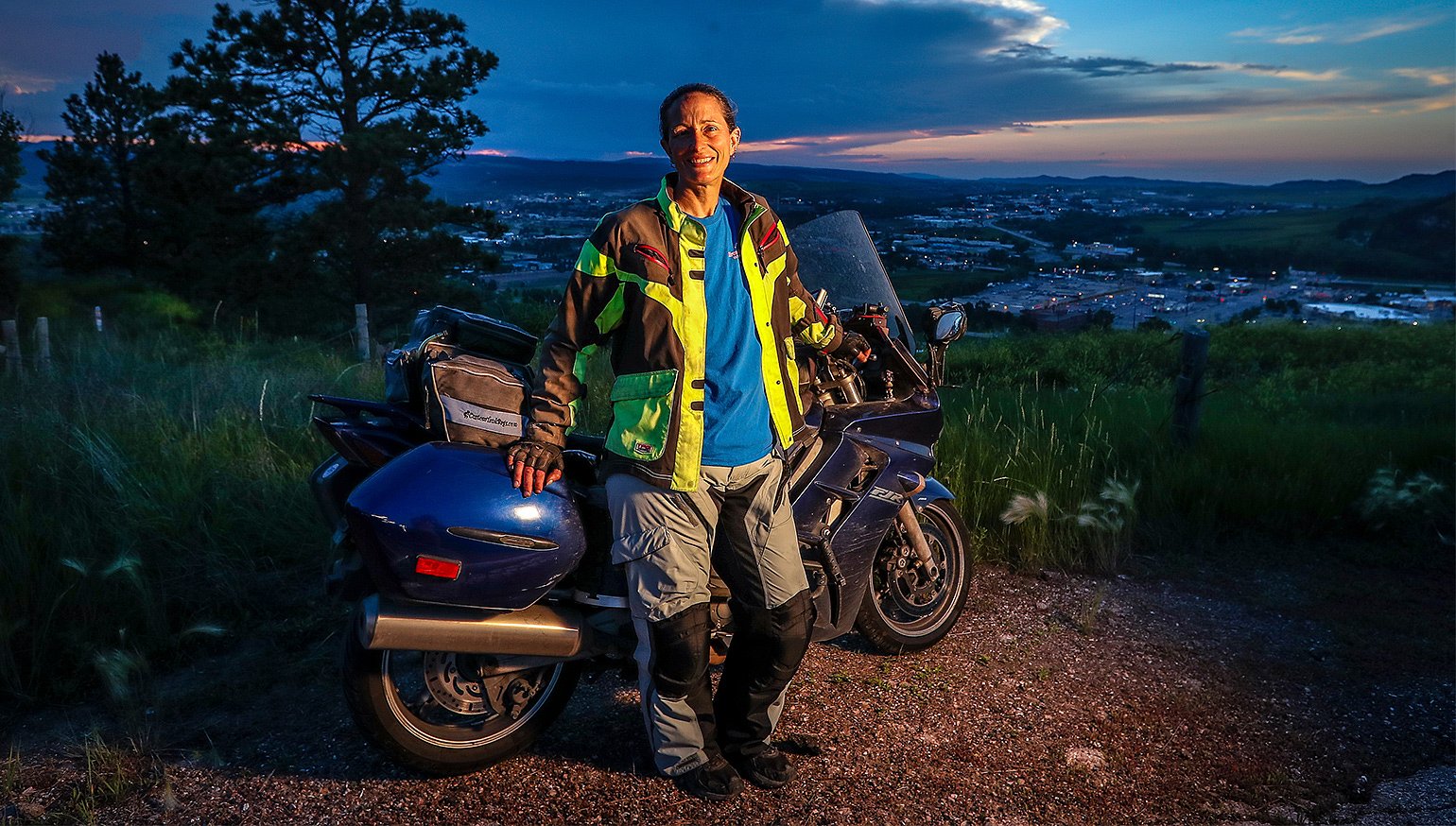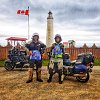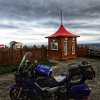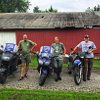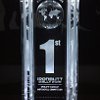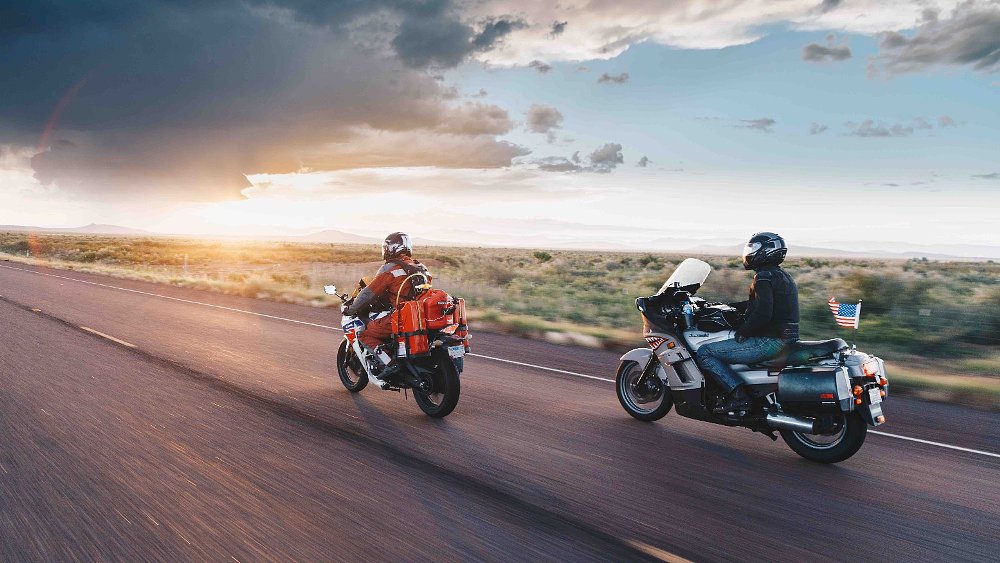Iron Butt history was made this month when Wendy Crockett became the first female rider to win the grueling Iron Butt Rally (IBR).
In 11 days, she rode 12,998.9 miles aboard her 2005 Yamaha FJR1300. The event marked Wendy’s fifth IBR and one of her greatest riding achievements to date. She’s completed more IBRs than any other woman. Her FJR’s completed more IBRs than any other motorcycle. A winning combination, apparently.
Lucky for us, Wendy took some time from her job as a motorcycle mechanic to answer a few questions. In addition to being a high-mileage maven, she turns wrenches for a living after graduating from MMI. She currently resides in Rapid City, South Dakota, though her true home seems to be the road.
Andy Greaser: Where did motorcycling begin for you?
Wendy Crockett: I don’t come from a motorcycle family, so I’m not quite sure where my fascination came from. I was just always drawn to motorcycles — the freedom, the motion, the uniqueness – but my mom said “over my dead body.” Of course, I started collecting motorcycles as soon as I moved out of the house. When I discovered the Iron Butt Association and my love for long-distance riding, it just felt like “This is it. This is why two wheels feels so right.”

AG: What’s your history with the Iron Butt Association?
WC: I became a member of the Iron Butt Association in 2004. My first certified ride combined a Saddle Sore (1,000 miles in 24 hours) with a 50cc (coast to coast in under 50 hours). I gathered a couple more certificate rides — a Bun Burner Gold (1,500 in under 24 hours), and Canada to Mexico in under 24 hours – before applying for the 11-day, 11,000-mile Iron Butt Rally. I hadn’t completed any other rallies at that time, but I was doing big solo miles on my own — I averaged about 50,000 miles per year — and also worked as a guide for a motorcycle tour company.

AG: You’ve ridden more in the last few years than many American riders will in a lifetime. What are some of your biggest motorcycling bragging rights?
WC: I’ve completed five Iron Butt Rallies, more than any other woman. My FJR has also completed five IBRs, more than any other single bike. I’ve ridden solo in every state except Hawaii and every province of Canada except Nunavut, which is not accessible by road. I’ve completed many rallies that are shorter than the IBR, ranging in length from 12 hours to 10 days, and brought home podium finishes in several of those, including one win. One of my proudest endurance riding certificates is my In-Newfoundland Saddle Sore. During the 2017 Iron Butt Rally, I was one of only five riders who managed to execute a seemingly impossible ride to Newfoundland, including more than 1,600 kilometers of riding on the island itself. Even though I made a serious mistake, which eliminated my hopes for a podium finish, I did manage to squeak out a top ten while having enjoyed one of the most amazing rides in Iron Butt history. The handful of riders who made that trek were dubbed the Newfy Five and while the certificate itself may seem relatively inconsequential, it’s a reminder that I did what many thought could not be done.
AG: 13,000 miles in 11 days is just incredible. What steps do you take to train for something like that?
WC: Many riders will make a point to put on big miles prior to big endurance rides, but it didn’t work out that way for me this year. We recently relocated to the Black Hills of South Dakota and had snow into early June, so up until I actually left home for the starting line, I’d only put on 886 miles in 2019. What I was able to do was focus on fine-tuning myself for the big ride. I walk/hike nine miles every morning, and I often load my 40-pound daughter up in a hiking pack for lengthy and aggressive hill climbs. This routine really helped to build core strength and physical endurance, which helped lessen the strain of long hours in the saddle and also helped me be more attuned to signs of fatigue. Having a four-year-old night owl and waking before sunrise to exercise also helped me acclimate to lower sleep requirements. Even now, a month after the rally, I will wake up without an alarm if I’ve been sleeping more than about five hours. I also focus on a strict diet, both leading up to and during the rally.

AG: What fuels you during these rides?
WC: In my early days of rallying I’d treat the rally as a dietary vacation, which was not very conducive to my rallying goals. I’d find myself constantly chasing sugar or caffeine crashes, which made it difficult to assess my actual fatigue level. By sticking to a strict, high-protein, low-carb diet, I’m able to maintain stable energy levels and more accurately assess my level of fatigue. I carry everything with me that I will eat during the course of the rally, outside of any meals I might eat at checkpoints. Even then, I make sure that the food I eat at checkpoints consists of lean protein and fiber and eschews empty carbs.
AG: In the Iron Butt Rally, riders have to reach certain checkpoints around North America, but the key is earning as many bonus points as possible on the way by stopping at bonus locations. What’s your strategy when laying out your route?
WC: Typically there are only a couple checkpoints, which are mandatory. There is a time window during which riders must reach the checkpoints, or they risk being time barred. Riders are rewarded for reaching bonus locations. The easiest way to think of this is as a gigantic North America-wide scavenger hunt. We are given a list of locations along with something we must procure — often just a picture, but sometimes a receipt or other physical object — in order to prove we were there during the time window allotted.
Each Iron Butt Rally has a different theme and supplies a different puzzle; this year’s theme was “The Road Less Traveled.” This theme had us going on the most beautiful, remote, and congested roads on the North American continent. I knew going in that the majority of these locations were going to be huge wildcards at best and giant time vacuums at worst. My strategy this year involved limiting those potential bottlenecks. I can do big miles without any trouble, so that was a factor within my control. What is not within my control are things such as construction zones, slow RVs, general congestion, low speed limits within parklands, detours, etc. My strategy was to limit these potential bottlenecks by looking for a small number of very big point bonuses. If a rider is looking to score big points while riding low miles by hitting, say, 30-plus bonus locations, that leaves him or her open to 30-plus potential bottlenecks. By choosing a route that involved bigger miles but only a handful of bonus locations, I significantly lessened the number of potential variables on my route. In this rally, that strategy paid off. I’m not concerned about sharing my approach, because next time the puzzle will be different and an entirely new approach will be required.

AG: How did you celebrate after finishing is year’s Iron Butt Rally? A roadside nap?
WC: The celebration for this win wasn’t just mine alone. There are so many strong riders in the community — women and men alike — who had put their faith in me. When my name was called the room just erupted in an energy that I can’t even explain. I could see almost the entire room leap to their feet and we all shared some tears. I did celebrate the following day by darn near cutting my head off. I had a bottle of hard cider left over from the celebration at the finish line and as I was walking into a hotel with this hot, agitated grenade, the bottle fell out of my bag, hit the ground and violently exploded. One of the shards came up and caught me right in front of my ear and gave me a pretty impressive cut. It probably could have used a few stitches, but I managed to get the bleeding stopped, slapped a few Band-Aids on it, and still make our dinner reservations nearly on time. What can I say; it was Brazilian barbeque and we’d only had three real meals in the preceding 11 days. Priorities, am I right?

AG: Any highlights you’d like to share from the trip, or heart-pounding moments?
WC: This year brought many highlights and very few heart-pounding moments. I rode to Mica Dam in British Columbia. The road was fantastic, the scenery was absolutely stunning, and I had it all to myself. It’s one of those places that you’re unlikely to ever stumble upon because there’s just no reason to be there, but one of those magnificent experiences you’re lucky to have in the course of a rally. Mount Washington was also a real joy. I’d ridden Mount Evans and Pikes Peak, so it was fun to have the opportunity to summit Mount Washington as well.
Puzzle-wise, I think the highlight had to be reaching the Cap-des-Rosiers lighthouse on the far end of the Gaspe Peninsula in Quebec. That was the culmination of an ambitious ride attempt, both in miles and in points. The timeline was very tight, the distractions were many, and the possibilities for delays lay around every corner. It was an amazing feeling to reach that bonus, lock down a massive thread, and know that I still had time to score some big points on my way in to the finish line.
As far as heart-pounding moments, I’d have to say it was the ferry crossing on Mobile Bay. I happened to cross paths with two other riders in queue for that ferry, and just minutes after we loaded up we were hit by a violent thunderstorm. The ferry was being pitched all over, waves were crashing over the car deck, and lightning was flashing all around us. It was so violent that strangers in other vehicles were asking us if we wanted to shelter in their cars. Unfortunately, the bikes weren’t tied down, so we had to stay with our bikes in order to keep them from falling over. We made it to the far side without any tipovers, but all of my electronics were glitchy for days following that event. But we all emerged from that ride otherwise unscathed. Also, there was the wasp sting in my pants…
AG: What bikes are in your garage, and how many miles have you racked up on them?

WC: Owning a motorcycle shop has lead to us owning a lot of motorcycles over the years, but when we moved recently the herd had to be culled. Between my husband and I we own two 2005 FJRs, a Yamaha FZ1, a Suzuki Bandit 1200 with a sidecar that our daughter rides in, a Honda XR50, a Yamaha snowmobile and a Cushman Truckster. There are always bikes coming and going, but these are the current core of our stable. My FJR has about 255,000 miles and my FZ1 has about half that; I bought both bikes brand new. My running tally for lifetime mileage is about 750,000 miles on two wheels.
AG: Gotta ask — what comfort modifications are you using?
WC: My comfort mods are many. If I had to pick one mod that I couldn’t live without, it would definitely be my Russell Day-Long custom saddle. I also have a handlebar risers, wonderfully squishy grip covers, four-quart hydration system, V-Stream touring windshield, four-gallon fuel cell, high intensity driving lights, highway pegs, and a perfect tank bag. I have several other technology items that I use as well: two GPS systems, Sena in-helmet communications system, toll road transponders, an InReach tracking beacon, and a mount that keeps my phone in reach. It’s not a bike mod, but I’ve been a long-time fan of my FirstGear riding gear. I use the ladies Monarch jacket and mens Kathmandu pants. The gear fits great, protects great, but most importantly has giant vents for hot days and waterproof zippers for wet days. This is great for my comfort since my brain absolutely refuses to let me stop to don rain gear; with this setup I can just open and close those waterproof zippers on the fly as needed. I also run heated gear for those chilly mornings.
AG: If someone wanted to start doing Iron Butt challenges, what advice would you give them as a rider? As a mechanic?
WC: Do it! Don’t worry about finding the perfect bike or buying all the bells and whistles or planning out everything to the Nth degree. Just do it. The best bike for embarking on certified rides is whatever bike you own right now. People have done Iron Butt Rallies on scooters, dual-sports, Ninja 300s, vintage bikes of all sorts. And that’s the 11-day, 11,000-mile rally! If you’re interesting in knocking out your first Saddle Sore, you can absolutely make it happen. Grab a paper map, gear up and hit the road. So many people spend so much time obsessing about how to orchestrate the exact perfect ride, when you already have everything you need.
As a mechanic I’d say just become comfortable with your machine. Know the basics, like what your tire pressure should be, how to adjust your chain if required, etc. Make sure your tires are in good condition with enough tread to last through your planned trip. A lot of smaller shops will be more than happy to show you some of the basics as they service your bike, so don’t be afraid to ask. I’m always happy to show you how to perform a safety inspection on your vehicle; I’d rather see you in the shop for regular services than for a wreck repair because you didn’t know how to assess your chain condition.
AG: Where’s the next place you want to ride?
WC: We’re actually getting ready to head out for our Next Great Adventure in just a couple months. We’re prepping up the sidecar rig and the FZ1 and we’re going to be spending the better part of the next year exploring around Central and South America. We have no set itinerary, just a loose wish list of things we’d like to see, but basically we just want to be completely open to enjoying the ride day-by-day and not feeling any pressure to keep to a schedule. I’ve already started documenting our preparations and will continue to share as our travels commence, so if you’re interested in following along you can check it out at thirdwheeladventures.com.




